|

 Up
Up 
 The Albert
The Albert
Medal

(You are here.)
 Down
Down




  Need
to Need
to
find your
bearings?
Try
these
navigation aids:
If
this is your first
visit, please stop by:
Something
to share?
Please:



|
|
Available in Française, Español, Português, Deutsch, Россию,
中文,
日本, and others.
 ortunately,
Orville Wright had an airplane too. ortunately,
Orville Wright had an airplane too.
On 17 December1903, after the Wrights had made four successful
flights, a gust of wind had rolled and smashed the Wright Flyer I,
rendering further test flights impossible without extensive repairs.
Anxious to get home for Christmas, the brothers dismantled the
Flyer, packed it in boxes, and shipped it to Dayton. They stored the
boxes in a shed near the back of their property, the same shed that
Orville occasionally used as a darkroom. There the boxes sat for
over 12 years.
In early 1916, after he had sold the
Wright Company, Orville began to restore the Flyer. He opened the
boxes for the first time since he had packed them in Kitty Hawk. We
can only imagine the mess that must have greeted him. Not only were
parts of the aircraft broken and missing, the boxes had been
submerged in river water for eleven days during the flood that
inundated Dayton in 1913. Pieces of the Flyer were covered with mud,
mildew, and rust.
It was a big
job, and Orville gathered several former employees of the Wright
Company to accomplish it, including Charlie Taylor, the machinist
who had built the engines for the Wright’s first airplanes. Orville, Charlie and crew
carefully cleaned, repaired, and replaced parts of the airplane. The
engine case had been broken and the crankshaft and flywheel lost.
Charlie cast and machined a new case, and then built up the engine,
borrowing parts
from old motors where he could find them and making them anew when
necessary. Over several months, Orville and his workmen carefully
restored the aircraft to its original condition, even
covering it with the same brand of cotton muslin the brothers has
used a dozen years before.
The restored 1903 Wright Flyer
I made its first public appearance at the Massachusetts
Institute of Technology on 11 through 14 June 1916. The occasion was
the opening of the new Cambridge Campus, and the Wright Flyer was
the guest of honor. Visitors were astounded to learn the aircraft
still existed. Alexander Graham Bell, who attended the event, was
bewildered that the Smithsonian had not acquired the aircraft. He
helped to arrange a meeting between Charles Walcott and Orville
Wright to discuss the possibility, but it produced no results. No
one knows exactly what was said at the meeting, but Orville left
feeling the Smithsonian was not especially interested. The Flyer
began to pop up infrequently at special aviation events; it next
appeared at the Pan-American Aeronautical Exhibition in New York in
February 1917 beside two modern Wright-Martin biplanes, a Model R
and a Model V. It would be displayed four more times between 1917 and 1924
– not often, but enough to remind folks that this valuable historic
artifact was “the first machine to fly,” according to its signage.
Several other people joined the
fight on Wright’s behalf. Orville’s sister Katharine began a
letter-writing campaign, impugning political figures such as Ohio
Governor James M. Cox to speak out against the Smithsonian’s
attempts to rewrite history. Earl Findley, a reporter for the New
York Herald who had worked with Orville for six months in an
aborted attempt to write a biography of the Wright brothers, weighed
in on their behalf. Harry Haskell, a journalist who had
attended Oberlin College with Katharine, wrote editorials for
the Kansas City Star and other newspapers.
The most effective counterpunches, however, came from Griffith
Brewer who, in effect, rallied all of England to the Wright
brothers' defense.
Of all the
characters in this drama, Brewer was probably the least
politically-motivated and at the same time, the most politically
adroit. Brewer was an accomplished balloonist and a patent attorney
who specialized in aeronautical patents. He had traveled to LeMans,
France in 1908 to see Wilbur fly. The two met, had dinner, found
they shared the same subtle sense of humor, and liked each other
immediately. On 8 October 1908, Wilbur treated Brewer to a flight,
making him the first Briton ever to fly in a powered aircraft. At
Wilbur’s invitation, Brewer visited the Wrights in America in the
summer of 1910 and became one of the first pupils at the Wright
Flying School. While there, he flew with Orville, making him one of
three people ever to fly with both of the Wright brothers.
Thereafter he made almost annual visits to Dayton, Ohio and Orville’s
summer home on Lambert Island, Ontario, thirty in all before he died
in 1948, the same year that Orville passed away.
Brewer put
together the British Wright Company to manage the Wright patents in
England. For a lawyer, he seemed much more interested in cooperation
than confrontation. He filed only a single patent infringement suit
on the Wright’s behalf, and it was this suit that Brewer had come to
America in 1914 to discuss with Orville. Instead of suing unlicensed
British aircraft manufacturers one at a time, Brewer had approached
their largest customer, the British military. He had discussed the
possibility of purchasing a blanket license for the Wright patent
that would cover any airplane manufactured in England. He had a
figure in mind – £25,000, approximately $125,000 at the 1914
exchange rate. Orville was amenable. He had recently committed to
buying back all the outstanding shares of stock in the Wright
Company and he needed the cash.
Before Brewer could return to
London and close negotiations, Europe descended into World War One.
In early August of 1914, England suddenly found itself in dire need
of military equipment, including thousands of airplanes. The funds
that the Royal Flying Corps and the Royal Naval Air Service had
earmarked for patent fees were suddenly very dear. Brewer begged Orville
to accept a lower payment and Orville acquiesced. The final amount
was just £15,000 ($75,000), which eventually worked out to just a
few dollars per airplane. Considering that the Wright Company had
charged the Burgess Company and others up to $1000 per aircraft,
this amounted to a generous contribution to the British war effort.
England was very much in Orville’s debt, and Brewer did not let them
forget it.
As the Smithsonian continued to
claim that the Aerodrome was the first true airplane, Brewer
suggested that England register an opinion to the contrary. In 1917,
the Royal Society of the Arts – of which Brewer was a Fellow –
awarded Orville Wright and his brother Wilbur (posthumously) the
Albert Medal, one of England’s highest civilian honors. This award
was created in 1864 to “acknowledge the profound creativity and
innovation of those that work to tackle some of the world's
intractable problems.” Only a handful of Americans had been so
esteemed, including Thomas Edison and Alexander Graham Bell.
On 27 October
1917, England sent a delegation to Dayton, Ohio headed by Lord
Northcliffe, owner/publisher of England’s Daily Mail and
London Times. Northcliffe brought with him prominent British
citizens from England’s government, military, sciences and commerce
to pay homage to the Wrights. They were met by similar folk from
America, including Ohio Governor James Cox, aeronaut Frank S. Lahm,
inventor Charles Kettering, and tycoon Charles Flint. Also present
were reporters from 147 news services worldwide. As he presented the
medal, Lord Northcliffe told the gathering, “Wilbur and Orville
Wright were the first persons to ascend from earth in a mechanically
propelled aeroplane. To them and to them only is due the credit.
Moreover, they were the real inventors of the means of controlling
all aeroplanes.”
And although he didn’t mention
the Smithsonian Institution by name, he leveled a powerful
accusation in their direction. “I hope that these words of mine will
have some effect upon checking those who are trying to rob your
citizens of their credit…There have been efforts made on the part of
others to claim the honor of designing and successfully flying the
first heavier-than-air machine. I bring messages from England from
persons in high authority that will serve to show that the Wright
brothers are regarded there as being justly entitled to this honor.
I want to do what I can to assure them the historical recognition
which is their due.”
The presentation of the Albert
Medal and Lord Northcliffe’s speech took place at Memorial Hall in
Dayton, Ohio. The centerpiece of this affair, suspended from the
flies over the stage, was the restored 1903 Wright Flyer I.
|
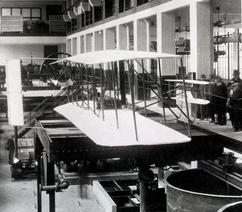
The restored 1903 Wright Flyer I
on display at the Massachusetts Institute of Technology in 1916.
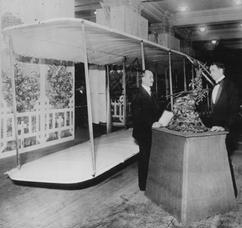
Orville Wright (left) and Glen Martin (right) with the restored Flyer at the Pan-American
Exhibition in New York City in 1917. Orville also displayed the
Michelin Cup that Wilbur won in 1908 for an endurance flight of over
two hours.
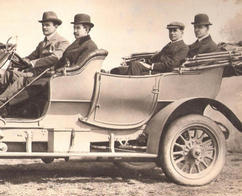
Griffith Brewer with Wilbur Wright (in the back seat) and Charles
Rolls and Orville Wright (in the front). The four visited the Royal
Aero Club on the Isle of Sheppey in Kent, England in 1909.
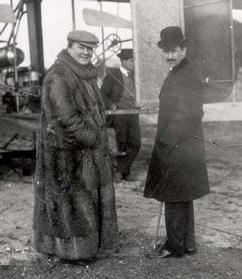
The Wright brothers also met Alfred Harmsworth,1st Viscount
Northcliffe (Lord Northcliffe) in 1909, while Wilbur was flying in
Pau, France. Seen here is Lord Northcliffe (left) in his distinctive
fur coat with Orville (right).
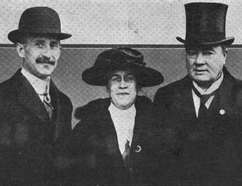
Orville and Katharine Wright with Lord Northcliffe (right) on 27
October 1917 on the occasion of the presentation of the Albert
Medal.
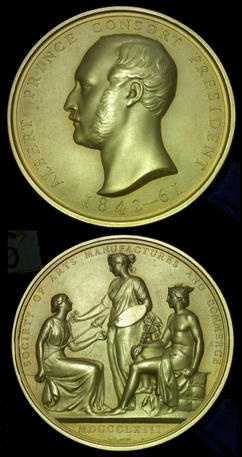
The Albert Medal of the Royal Society of the Arts.
|